
Arcology, a portmanteau of "architecture" and "ecology", is a field of creating architectural design principles for very densely populated and ecologically low-impact human habitats.

James Graham Ballard was an English novelist and short-story writer, satirist and essayist known for psychologically provocative works of fiction that explore the relations between human psychology, technology, sex and mass media. Ballard first became associated with New Wave science fiction for post-apocalyptic novels such as The Drowned World (1962). He later courted controversy with the short-story collection The Atrocity Exhibition (1970), which includes the 1968 story "Why I Want to Fuck Ronald Reagan", and later the novel Crash (1973), a story about car-crash fetishists.

Apocalyptic and post-apocalyptic fiction is a subgenre of science fiction in which the Earth's civilization is collapsing or has collapsed. The apocalypse event may be climatic, such as runaway climate change; astronomical, an impact event; destructive, nuclear holocaust or resource depletion; medical, a pandemic, whether natural or human-caused; end time, such as the Last Judgment, Second Coming or Ragnarök; or any other scenario in which the outcome is apocalyptic, such as a zombie apocalypse, AI takeover, technological singularity, dysgenics or alien invasion.

Orphans of the Sky is a science fiction novel by American writer Robert A. Heinlein (1907–1988), consisting of two parts: "Universe" and its sequel, "Common Sense". The two novellas were first published together in book form in 1963. "Universe" was also published separately in 1951 as a 10¢ Dell paperback. The work presents one of the earliest fictional depictions of a generation ship.

The overwhelming majority of fiction is set on or features the Earth, as the only planet home to humans or known to have life. This also holds true of science fiction, despite perceptions to the contrary. Works that focus specifically on Earth may do so holistically, treating the planet as one semi-biological entity. Counterfactual depictions of the shape of the Earth, be it flat or hollow, are occasionally featured. A personified, living Earth appears in a handful of works. In works set in the far future, Earth can be a center of space-faring human civilization, or just one of many inhabited planets of a galactic empire, and sometimes destroyed by ecological disaster or nuclear war or otherwise forgotten or lost.
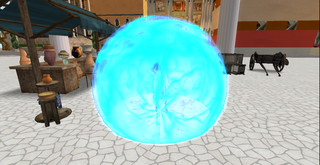
In speculative fiction, a force field, sometimes known as an energy shield, force shield, energy bubble, or deflector shield, is a barrier produced by something like energy, negative energy, dark energy, electromagnetic fields, gravitational fields, electric fields, quantum fields, telekinetic fields, plasma, particles, radiation, solid light, magic, or pure force. It protects a person, area, or object from attacks or intrusions, or even deflects energy attacks back at the attacker. This fictional technology is created as a field of energy without matter that acts as a wall, so that objects affected by the particular force relating to the field are unable to pass through the field and reach the other side, instead being deflected or destroyed. Actual research in the 21st century has looked into the potential to deflect radiation or cosmic rays, as well as more extensive shielding.
The concept of self-replicating spacecraft, as envisioned by mathematician John von Neumann, has been described by futurists and has been discussed across a wide breadth of hard science fiction novels and stories. Self-replicating probes are sometimes referred to as von Neumann probes. Self-replicating spacecraft would in some ways either mimic or echo the features of living organisms or viruses.
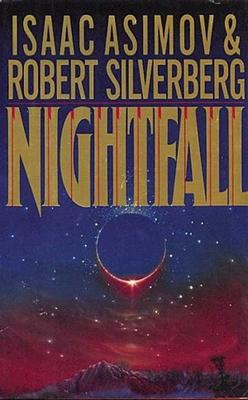
"Nightfall" is a 1941 science fiction short story by the American writer Isaac Asimov about the coming of darkness to the people of a planet ordinarily illuminated by sunlight at all times. It was adapted into a novel with Robert Silverberg in 1990. The short story has appeared in many anthologies and six collections of Asimov stories. In 1968, the Science Fiction Writers of America voted "Nightfall" the best science fiction short story written prior to the 1965 establishment of the Nebula Awards and included it in The Science Fiction Hall of Fame, Volume One, 1929–1964.
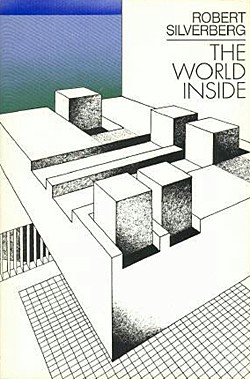
The World Inside is a science fiction novel by American writer Robert Silverberg, published in 1971. The novel originally appeared as a series of shorter works in 1970 and 1971, all but one published in Galaxy, including the Hugo nominated novella "The World Outside". The World Inside was nominated for a Hugo Award in 1972, although Silverberg declined the nomination.

The Wind from Nowhere is a science fiction novel by English author J. G. Ballard. Published in 1962, it was his debut novel. He had previously published only short stories.
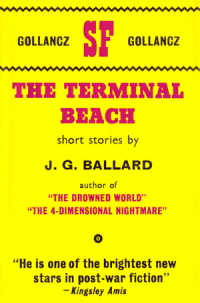
The Terminal Beach is a collection of science fiction short stories by British author J. G. Ballard, published in 1964.
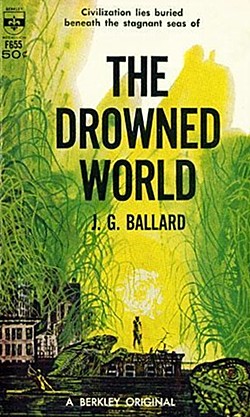
The Drowned World (1962), by J. G. Ballard, is a British science fiction novel that depicts a post-apocalyptic future in which global warming, caused by increased solar radiation, has rendered uninhabitable much of the surface of planet Earth. The story follows a team of scientists researching environmental developments in the flooded city of London. The novel is an expansion of the novella "The Drowned World", which was first published in Science Fiction Adventures magazine, in the January 1962 issue, Vol. 4, No. 24.

Scientology founder L. Ron Hubbard routinely referred to "space opera" in his teachings, drawing from science-fiction and weaving it into his origins of human history. In his writings, wherein thetans were reincarnated periodically over quadrillions of years, retaining memories of prior lives, to which Hubbard attributed complex narratives about life throughout the universe. The most controversial of these myths is the story of Xenu, to whom Hubbard attributed responsibility for many of the world's problems.
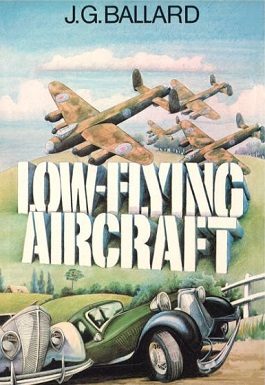
Low-Flying Aircraft and Other Stories is a collection of science fiction short stories by British writer J. G. Ballard published in 1976.
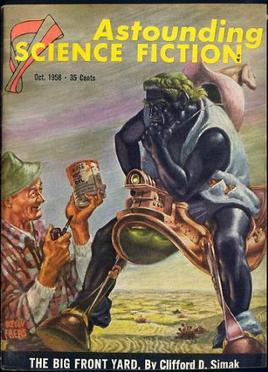
"The Big Front Yard" is a science fiction short story by American writer Clifford D. Simak which won a 1959 Hugo Award for Best Novelette. It was also included in The Science Fiction Hall of Fame, Volume Two (1973) after being voted one of the best novellas up to 1965.
"Studio 5, The Stars" is a short story by British author J. G. Ballard. First appearing in the February 1961 edition of Science Fantasy ; it was reprinted in the collection Billennium the following year. It later appeared in The Four-Dimensional Nightmare (1964), Vermilion Sands (1971) and The Complete Short Stories of J. G. Ballard (2006).
"Deep End" is a short story written in 1961 by British author J. G. Ballard. It first appeared in the May 1961 edition of New Worlds and then in the 1962 collection The Voices of Time and Other Stories followed by The Complete Short Stories of J. G. Ballard: Volume 1 in 2006. The tale is typical of Ballard's dystopian science fiction.
Billenium is a short story by British author J. G. Ballard, first published in the November 1961 issue of New Worlds and in the 1962 collection Billennium. It later appeared in The Terminal Beach (1964), Chronopolis and Other Stories (1971), and The Complete Short Stories of J. G. Ballard: Volume 1 (2006). With a dystopian ambience, "Billennium" explores themes similar to Ballard's earlier story "The Concentration City", of space shortages and over-crowding.
"The Sound-Sweep" is a short story by British writer J. G. Ballard. It was first published in Science Fantasy, Volume 13, Number 39, February 1960 and was reprinted in the collection The Four-Dimensional Nightmare.
Inner space in the context of science fiction refers to works of psychological science fiction focusing on the internal, mental experiences. Works from this genre appeared as part of the emergence of the New Wave in science fiction in the 1960s.













